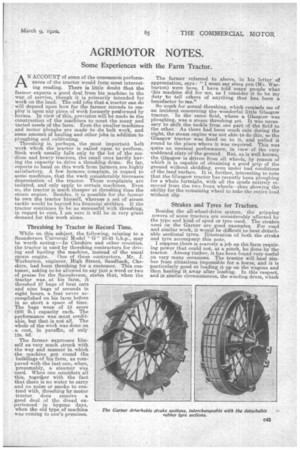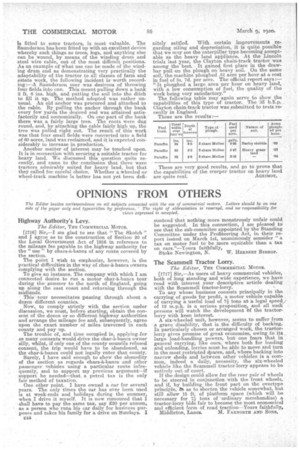AGRIMOTOR NOTES.
Page 23

Page 24

If you've noticed an error in this article please click here to report it so we can fix it.
Some Experiences with the Farm Tractor.
AN ACCOUNT of some of the uncommon performances of the tractor would form most interesting reading. There is little doubt that the farmer expects a good deal from his machine in the way of service though it is primarily intended for work on the land. The odd jobs that a tractor ean do will depend upon how far the farmer intends to employ it upon any piece of work formerly performed by horses. In view of this, provision will be made in the construction of the machines to meet the many and varied needs of the farm. Even the smaller machines and motor ploughs are made to do belt work, and some amount of hauling and other jobs in addition to ploughing and cultivating. Threshing is, perhaps, the most important belt work which the tractor is called upon to perform. Such work usually falls only to the lot of the medium and heavy-tractors, the small ones hardly having the capacity to drive a threshing drum. So far, reports to hand on this work from farmers are highly satisfactory. A few farmers complain, in regard to some maohines, that the work considerably increases depreciation of the tractor. These complaints are isolated, and only apply to certain machines. Even so, the tractor is much cheaper at threshing than the steam engine. Besides, it is possible for the farmer to own the tractor himself, whereas a set of steam tackle would be beyond his financial abilities. If the tractor continues to be as successful with threshing, in regard to cost, I am sure it will be in very great demand for this work alone.
Threshing by Tractor in Record Time.
While on this subject. the following, relating to a. Saunderson Universal Model " G" 23-25 b.h.p., may be worth noting :—In Cheshire and other counties, the tractor is used by threshing contractors for driving and hauling the machine, instead of the usual
The farmer expresses himself as very much struck with the way and manner in which the machine got round the buiklihgs of his farm, as compared with the last one, when, presumably, a steamer was used. When one considers all this, together with the fact that there is no water to carry and no noise or smoke to contend with, threshing by motor tractor does remove a good deal, of the dread experienced in bygone days, when the old type of machine was coming to one's premises.
The farmer referred to above, in his letter of appreciation, says: "I must say since you (Mr. Warburton) were here, I have told many people what this machine did for me, as I consider it to be my duty to tell others of anything that has been a benefactor to me."
So 'much for actual threshing, which reminds me of an incident concerning the wonderful little Glasgow tractor. In the same field, where a Glasgow was ploughing, was a steam threshing set. It was necessary to shift the tackle from one part of the fieldto the other. As there had been much rain during the night, the steam engine was not able to do this, so the Glasgow tractor was fixed on to it, and pulled it round to the place where it was required. This was quite an unusual performance, in view of the very saddened state of the ground. But, as is well known, the Glasgow is driven from all wheels, by reason of which it is capable of obtaining a good grip of the ground without skidding-, even under bad conditions of the land surface. It is' further, interesting to note that the Glasgow tractor has recently been ploughing for a whole fortnight, with all the spuds entirely removed from the two front wheels—thus showing the. ability for the remaining wheel to take the entire load without slip
Shakes and Tyres for Tractors.
Besides the all-wheel-drive system, the gripping sowers of some tractors are considerably affected by the type and kind of spud or tyre used. The stra.kes used on the Garner are good examples. For road and similar work, it would be difficult to beat detachable sectional tyres. Illustration of both the strake and tyre accompany this note.
I suppose there is scarcely a job on the farm requiring power that could not, at a pinch, be done by the tractor. Among timber, it has been found very useful on very many occasions. The tractor will haul timber from Situations impossible for a horse, and it is particularly good at loading it up on the wagons and then hauling it away after loading. In this respect, and in similar circumstances, the winding drum, which is fitted to some tractors, is most valuable. The Saunderson has been fitted up with an excellent device whereby such things as trees, legs, and anything else can be wound, by means of the winding drum and steel wire cable, out of the most difficult positions. As an example of What use can be made of the winding drum and as demonstrating very practically the adaptability of the tractor to all classes of farm and estate work, the following incident isworth recording:—A Saunderson user was desirous of throwing four fields into one.. This meant pulling down a bank 2 ft. 6 ins, high, and putting the soil into the ditch to fill it up. The method adopted was rather unusual. An old anchor was procured and attached to the cable. By pulling the anchor through the bank every few yards the desired end was attained satisfactorily and economically. On one part of the bank there was a fairly large tree. The roots were dug round, and, by attaching the cable fairly high up, the tree was pulled right out. The result of this work was that four small fields were converted into a field of 60 acres, land was reclaimed, and it is expected considerably to increase in production. Another matter of interest may be touched upon. It is in connection with securing a suitable tractor for heavy land. We discussed this question quite recently, and came to the conclusion that there were tractors admirably suited for heavy land, but that theycalled for careful choice. Whether a wheeled or wheel-track machine is better has not yet been deli nitely settled. With certain improvements regarding oiling and depreciation, it is quite possible that we may see the caterpillar type becoming acceptable a;s the heavy land appliance. At the Lincoln trials last year, the Clayton chain-track tractor was among the best. It gained first place in the drawbar pull on the plo-ugh on heavy soil. On the same soil, the ma-chine ploughed .81 acre per hour at a cost in fuel of 3s. 7d. per acre. The official report says :"it ploughed a large area per hour on heavy land, with a low consumption of fuel, the quality of the work being very satisfactory." The following table may again serve -Co show the capabilities of this type of tractor. The 33, Clayton chain-track tractor was submitted to tests recently in England.
These are the results:— These are very good results, and go to prove that the capabilities of the creeper tractor on heavy land
are quite real. AGRIMOT.


























